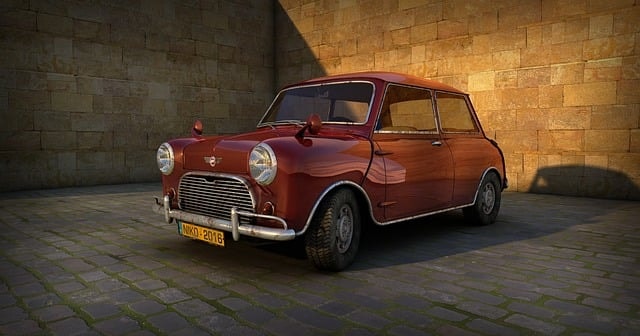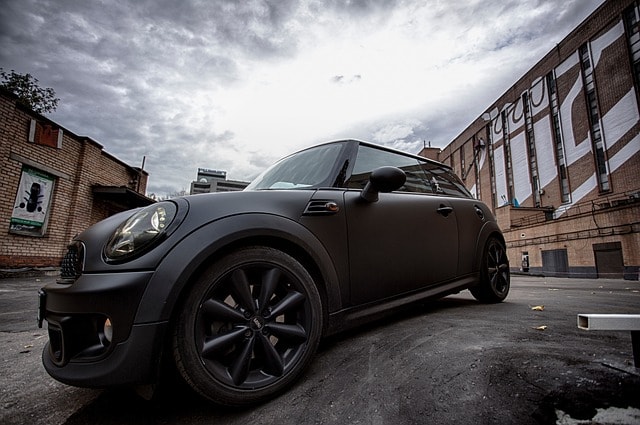Old Mini cars, known for their innovative design and cultural impact, are iconic. This article will explore their origins, iconic models, and lasting legacy. Discover why these mini cars old have left a big mark on automotive history.
Table of Contents
Key Takeaways
The Mini was developed in the late 1950s as a response to fuel shortages, with innovative design features that maximized interior space while maintaining compact dimensions.
Over the decades, the Mini evolved through multiple models, notably the Mark I, II, and III, each introducing refinements that enhanced comfort, usability, and aesthetic appeal.
The Mini’s legacy includes significant success in motorsports, cultural impact, and a production history that spanned over 40 years, solidifying its status as an enduring symbol of innovative automotive design.
The Birth of the Mini

The story of the Mini begins in the mid-1950s, a time when the world was grappling with the aftermath of the Suez Crisis. This geopolitical event resulted in oil shortages and soaring fuel prices, creating a demand for smaller, more fuel-efficient vehicles. It was against this backdrop that Leonard Lord of the Morris Company issued a challenge to Alec Issigonis: to design a compact car that was both affordable and efficient.
Alec Issigonis rose to the occasion with a groundbreaking design that would revolutionize the automotive industry. He innovated by positioning the engine sideways and placing the wheels at the corners of the car, which not only enhanced stability but also maximized interior space. This clever use of space was a hallmark of the Mini, allowing it to offer more room for passengers and luggage than any other car of its size at the time.
The original Mini was introduced to the world in 1959, and it quickly became a cultural phenomenon. Its compact dimensions, combined with its distinctive styling and practical design, made it an instant hit. The Mini’s ability to navigate narrow streets and park in tight spots made it particularly suited for urban environments, and its affordability made it accessible to a wide range of consumers.
The Mini’s debut marked the beginning of a new era for small cars. It wasn’t just a vehicle; it was a statement of style and innovation. The Mini’s unique design and exceptional space efficiency set it apart from other cars, cementing its place as a beloved classic and an enduring symbol of British automotive excellence.
Early Models: A Look Back

The first Mini models, the Morris Mini Minor and the Austin Mini, were meticulously designed to meet the challenge of creating a compact car that did not compromise on interior space. Sir Alec Issigonis, the mastermind behind the Mini, focused on space efficiency, resulting in features like the uniquely large door pockets that maximized storage within the compact dimensions of the car.
In addition to their practical design, the early models of the Mini boasted charming aesthetic features. The Morris Mini Traveller and Austin Mini Countryman, for instance, were adorned with decorative ash wood trim on the rear body, adding a touch of elegance to their utilitarian design. These variants were produced in significant numbers, with approximately 108,000 units of the Austin Mini Countryman and about 99,000 units of the Morris Mini Travellers being built.
These early models laid the foundation for the Mini’s enduring popularity. They showcased the innovative spirit and practical design that would become synonymous with the Mini brand. The combination of space efficiency, unique styling, and practical features made these early Minis icons in their own right, setting the stage for the evolution and success of future Mini models.
Evolution Over the Decades
The Mini’s journey through the decades is a testament to its ability to adapt and evolve while staying true to its core principles. Each iteration brought with it new features and improvements, reflecting the changing needs and preferences of drivers. The transition from the Mark I to the Mark II and subsequently to the Mark III marks significant milestones in the Mini’s evolution.
The Mark I, produced between 1959 and 1967, was the first step in this evolutionary journey. Designed by Sir Alec Issigonis, it introduced several innovative features that set it apart from other small cars of its time. The transverse engine layout, sliding windows, and radial tires were just a few of the design elements that made the Mark I a revolutionary vehicle.
The Mark II, produced from 1967 to 1970, brought further refinements to the Mini’s design. Larger rear windows improved visibility and overall comfort, reflecting the continuous improvements in response to user feedback and technological advancements.
The Mark III, produced between 1969 and 1976, marked a significant evolution in the Mini’s design and functionality. The introduction of wind-up windows, a redesigned suspension system, and larger doors with concealed hinges were some of the key changes that enhanced the driving experience and comfort. These updates not only improved the car’s aesthetics but also its practical usability, setting the stage for future models in the Mini range.
The Mark I (1959-1967)
The Mark I Mini, produced between 1959 and 1967, was a revolutionary vehicle that set the standard for compact car design. Sir Alec Issigonis’ innovative approach to maximizing interior space while maintaining a small exterior footprint was evident. The transverse engine layout was a key feature that allowed for a more spacious interior, which was a significant advantage over other small cars of the time.
One of the distinctive features of the Mark I was its sliding windows. This design choice not only contributed to the car’s compact size but also enhanced its practicality by allowing for more storage space within the doors. Additionally, the use of radial tires was an innovative choice that improved the car’s handling and stability, making it a pleasure to drive.
The Mark I Mini’s combination of innovative design and practical features made it an instant success. It set the stage for the subsequent iterations of the Mini, each of which built upon the strengths of the Mark I while introducing new improvements and refinements.
The Mark II (1967-1970)
The Mark II Mini, produced from 1967 to 1970, introduced several refinements that built upon the design of its predecessor. One of the most notable changes was the larger rear windows, which significantly enhanced visibility and overall comfort for passengers. These improvements responded directly to user feedback and reflected the Mini’s continuous evolution to meet its drivers’ needs.
In addition to the larger rear windows, the Mark II featured other design enhancements that contributed to a more comfortable and enjoyable driving experience. These refinements, although subtle, demonstrated the British Motor Corporation’s commitment to continually improving the Mini, ensuring that it remained a popular choice among small car enthusiasts.
The Mark III (1969-1976)
The Mark III Mini, produced between 1969 and 1976, represented a significant evolution in the Mini’s design and functionality. Notably, wind-up windows replaced the earlier sliding window design. This change not only modernized the car’s appearance but also improved its practicality and user experience.
The Mark III also featured a redesigned suspension system, which enhanced the car’s handling and comfort. Additionally, the structural updates included larger doors with concealed hinges, further improving the car’s aesthetics and functionality. These changes contributed to a more refined driving experience, making the Mark III a significant step forward in the Mini’s evolution.
The improvements introduced with the Mark III set the stage for future Mini models. By enhancing comfort, drivability, and aesthetic appeal, the Mark III ensured that the Mini remained a competitive and desirable option in the small car market.
Popular Variants and Special Editions

The Mini’s popularity was further bolstered by a range of variants and special editions that catered to different tastes and needs. Among these, the Mini Cooper and Cooper S, Wolseley Hornet and Riley Elf, and Mini Moke stand out as particularly notable examples.
Developed in collaboration between Alec Issigonis and John Cooper, the Morris Mini Cooper and Cooper S emphasized high-performance capabilities that have become legendary in motorsports. The Wolseley Hornet and Riley Elf, on the other hand, were luxury variants that offered unique styling and premium features, setting them apart from the standard Mini models.
Finally, the Mini Moke, originally designed for military use, found its niche as a versatile and popular recreational vehicle. These variants and special editions not only expanded the Mini’s appeal but also demonstrated the versatility and adaptability of the Mini platform. They catered to a wide range of consumers, from performance enthusiasts to those seeking luxury or practical utility.
Mini Cooper and Cooper S
The Mini Cooper and Cooper S emerged from a collaboration between Alec Issigonis and John Cooper, driven by their shared passion for performance. John Cooper, a renowned race car designer, saw the potential in the Mini’s compact design and approached Issigonis with the idea of creating a high-performance version of the car. This partnership resulted in the Austin Mini Cooper, which made its debut in September 1961.
The Mini Cooper was designed with performance in mind. It featured a more powerful engine, upgraded brakes, and a revised suspension system, all of which contributed to its impressive handling and speed. The Cooper S, an even more potent version, further enhanced these features, making it a formidable competitor in motorsports.
The success of the Mini Cooper and Cooper S in racing events, particularly in the Monte Carlo Rally, cemented their status as iconic performance cars. Their legacy continues to this day, with the Mini Cooper name still synonymous with sporty driving and racing success.
Wolseley Hornet and Riley Elf
The Wolseley Hornet and Riley Elf represented the luxury side of the Mini range. These models were designed to offer a more upscale experience, featuring unique styling elements and premium interiors. The Wolseley Hornet, for example, had a distinctive front grille and elongated rear, giving it a more refined appearance.
The Riley Elf, marketed as an even more luxurious variant, boasted a richer interior with more leather and wood finishes. Both models catered to consumers who wanted the practicality and charm of a Mini but with added comfort and style. These luxury variants demonstrated the versatility of the Mini platform and its ability to appeal to a broader audience.
Mini Moke
The Mini Moke was originally designed as a military utility vehicle for the British Army. Its compact size and utilitarian design made it suitable for various logistical needs, including transport and light reconnaissance. However, its potential as a military vehicle was limited by its low ground clearance and lack of four-wheel drive.
Despite this, the Mini Moke found a second life in the civilian market. Its simple, rugged design and versatility made it popular as a recreational vehicle. It was particularly well-suited for use in beach resorts and other leisure environments, where its open-air design and ease of maintenance were highly valued.
The Mini Moke’s transition from a military utility vehicle to a beloved civilian car underscores the adaptability and broad appeal of the Mini platform. It remains a cherished part of the Mini’s legacy, known for its distinctive style and practical design.
Commercial Success: Vans and Pick-ups
The commercial success of the Mini extended beyond its passenger cars to include practical utility vehicles like the Mini Van and Mini Pick-up, which played a crucial role in enhancing the Mini brand’s commercial viability and overall sales.
The Mini Van, with its impressive load capacity and compact size, became a popular choice for businesses and tradespeople. Similarly, the Mini Pick-up combined the Mini’s trademark style with the practicality needed for various commercial applications.
These utility-focused versions of the Mini demonstrated the brand’s versatility and ability to meet a wide range of consumer needs. They contributed significantly to the Mini’s overall success and helped cement its reputation as a practical, reliable, and stylish vehicle.
Mini Van (1960-1983)
Produced between 1960 and 1983, the Mini Van was a significant commercial success for the Mini brand. With 521,494 units built, its practicality and compact design made it a popular choice for various commercial uses. Its load capacity of 14 tons was particularly impressive, allowing it to handle a wide range of cargo needs.
In 1978, the Mini Van was renamed the Mini 95, marking a new phase in its production run. Despite the name change, the Mini Van continued to be a reliable and versatile vehicle, beloved by businesses for its practicality and efficiency.
The Mini Van’s success underscored the Mini’s ability to adapt to different market segments and meet the needs of a diverse customer base. Its combination of practicality and charm made it a lasting favorite in the commercial vehicle market.
Mini Pick-up (1961-1983)
Produced from 1961 to 1983, the Mini Pick-up was another successful commercial vehicle in the Mini range. A total of 58,179 units were built during its production run, reflecting its popularity among businesses and individual consumers. The Mini Pick-up’s compact size and lightweight design, with a total length of 11 feet and a weight of less than 1,500 pounds with a full tank, made it a practical and efficient choice for various applications.
The Mini Pick-up’s unique combination of style and practicality made it a standout in the commercial vehicle market. Its success further demonstrated the versatility of the Mini platform and its ability to cater to a wide range of consumer needs.
Iconic Features of Classic Minis
Several iconic features set the classic Mini apart and contributed to its enduring popularity. The front-wheel-drive configuration, compact design, and unique styling were key elements that made the Mini a revolutionary vehicle in its time. The front-wheel-drive system maximized interior space, enhancing passenger comfort and cargo capacity.
The Mini’s compact design allowed it to easily navigate narrow streets and park in tight spots, making it a practical choice for urban environments. Additionally, the Mini’s charming aesthetics, characterized by rounded shapes and a minimalistic yet functional design, gave it a distinctive and appealing style.
These iconic features not only defined the Mini but also influenced the design of small cars for generations to come. They helped establish the Mini as a beloved classic and an enduring symbol of innovative automotive design.
Front Wheel Drive
The front-wheel-drive system in the classic Mini was a groundbreaking innovation that contributed to its success, providing better traction and improved handling, especially in tight corners. By placing the gearbox beneath the engine, the Mini’s front-wheel-drive design also maximized interior space, allowing for a more compact vehicle without compromising passenger comfort or cargo capacity.
The advantages of the front-wheel-drive system were particularly evident in urban driving, where the Mini’s agility and stability made it a practical and enjoyable car to drive. This innovative design choice set the Mini apart from other small cars of its time and contributed to its lasting popularity.
Compact Design
The Mini’s compact design was one of its most defining features. The small footprint of the Mini made it exceptionally suited for urban environments, allowing for easy parking and maneuverability. This was a significant advantage in crowded cities, where finding parking and navigating narrow streets could be challenging for larger vehicles.
The innovative design of the Mark I Mini included sliding windows, which further contributed to its compact size. This design choice not only saved space but also enhanced the car’s practicality by allowing for more storage within the doors.
The Mini’s small dimensions made it an ideal choice for city driving, allowing users to maneuver through congested areas more effectively. This practicality, combined with its charming aesthetics, endeared the Mini to urban dwellers and car enthusiasts alike.
Unique Styling
The unique styling of the classic Mini is one of the reasons it remains an iconic and beloved vehicle. The Mini’s small stature and practical design set it apart aesthetically from other cars, giving it a distinctive and charming appearance. The rounded shapes and minimalistic yet functional design emphasized utility while maintaining an appealing style.
The use of decorative elements, such as the wood trim on models like the Morris Mini Traveller and Austin Mini Countryman, added a touch of elegance to the Mini’s practical design. These unique styling elements contributed to the Mini’s enduring charm and helped establish it as a classic in automotive history.
Learn more, checkout 5 reasons why the classic Mini is iconic.
Mini Cars in Motorsports
The Mini’s success extended beyond the streets into the world of motorsports, achieving remarkable feats. The Mini Cooper S, in particular, made a significant impact in racing, dominating events such as the Monte Carlo Rally during the 1960s. Its impressive performance and agility earned it a reputation as a formidable competitor.
In addition to its success in the Monte Carlo Rally, the Mini also excelled in the British Saloon Car Championship, winning multiple titles between 1961 and 1979. The Mini’s achievements in motorsports were a testament to its exceptional design and performance capabilities.
The Mini’s dominance was further demonstrated in the 1966 Gallaher 500 at Bathurst, where it finished in the top nine spots. These victories solidified the Mini’s legacy in motorsports and contributed to its enduring popularity among racing enthusiasts.
The Legacy of Mini Cars Old
The legacy of the classic Mini is one of innovation, cultural significance, and lasting impact. The Mini was considered the second most significant car of the 20th century in a global automotive competition, a testament to its revolutionary design and enduring influence. Its innovative layout and space efficiency have had a lasting impact on automotive engineering and culture.
The Mini’s success in motorsports, including over 30 significant wins in international rallying events and three victories in the Monte Carlo Rally during the 1960s, further cemented its legacy. These achievements highlighted the Mini’s exceptional performance and versatility.
The production of classic Mini models spanned more than 40 years, with total sales reaching approximately 5.3 million units. The final variant produced, the Mark VII, marked the end of an era for the classic Mini. Despite this, the Mini’s legacy lives on, influencing modern car design and continuing to captivate car enthusiasts around the world.
The Mini’s cultural impact is also noteworthy. It has been featured in numerous films, television shows, and advertisements, becoming a symbol of British style and ingenuity. The classic Mini’s ability to accommodate up to 27 people in a Guinness World Record event is a testament to its innovative design and enduring appeal.
Summary
The journey of the classic Mini is a story of innovation, resilience, and timeless charm. From its inception in response to the economic challenges of the Suez Crisis to its evolution through various models and special editions, the Mini has continually adapted to meet the needs of its drivers. Its success in motorsports and its enduring cultural impact have cemented its place as a beloved classic.
The Mini’s iconic features, including its front-wheel-drive configuration, compact design, and unique styling, have set it apart from other small cars and influenced automotive design for generations. Its practical and stylish design made it a favorite among urban drivers and car enthusiasts alike.
As we reflect on the legacy of the classic Mini, we are reminded of its lasting impact on automotive history and culture. The Mini’s story is a testament to the power of innovative design and the enduring appeal of a car that redefined what was possible for small cars. The classic Mini continues to inspire and captivate, proving that great things can come in small packages.
Frequently Asked Questions
Why was the Mini created?
The Mini was created to address the need for smaller, more fuel-efficient vehicles in response to the Suez Crisis. This necessity for practicality and economy in transportation led to its development.
What were the first Mini models?
The first Mini models were the Morris Mini Minor and the Austin Mini.
What made the Mini Cooper and Cooper S special?
The Mini Cooper and Cooper S are distinguished by their performance-oriented design and notable achievements in motorsports. These features have solidified their status as iconic vehicles in automotive history.
How did the Mini’s design change over the years?
The Mini’s design changed significantly across its various Marks, particularly in terms of body structure, window configurations, and suspension systems. These modifications reflected advancements in automotive technology and consumer preferences over the years.
What is the legacy of the classic Mini?
The legacy of the classic Mini is defined by its innovative design, significant cultural influence, and notable success in motorsports, with over 5.3 million units produced. This iconic vehicle has left an enduring mark on automotive history.









